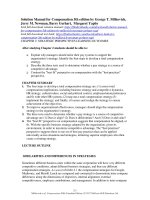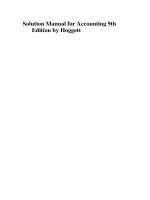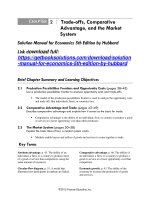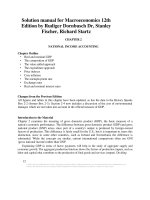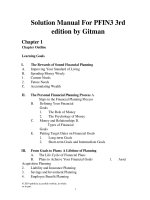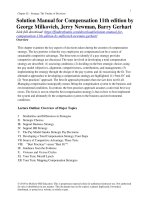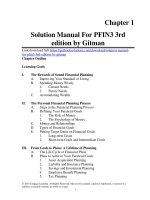Solution manual for chemistry 4th edition by burdge
Bạn đang xem bản rút gọn của tài liệu. Xem và tải ngay bản đầy đủ của tài liệu tại đây (376.27 KB, 42 trang )
Solution Manual for Chemistry 4th Edition by Burdge
Chapter 1
Chemistry: The Central Science
Practice Problems C
1.1
(iii)
1.2
(i) and (i)
1.3
pink liquid = grey solid < blue solid < yellow liquid < blue liquid < green solid
1.4
physical: (iii), chemical: (i), (ii) is neither
1.5
12 blue cubes, infinite number of significant figures;
2 × 101 red spheres, one significant figure
1.6
2.4 × 102 lbs.
1.7
2.67 g/cm3
1.8
(a) 4 red blocks/1 object
(b) 1 object/1 yellow block
(c) 2 white blocks/1 yellow block
(d) 1 yellow block/6 grey connectors
1.9
375 red bars; 3500 yellow balls
Applying What You’ve Learned
a)
The recommended storage-temperature range for cidofovir is 20°C−25°C.
b)
The density of the fluid in a vial is 1.18 g/mL. (The density should be reported to three significant figures.)
c)
The recommended dosage of cidofovir for a 177-lb man is 4 × 102 mg or 0.4 g.
d)
1.18 × 103 g/L, 1.18 × 103 kg/m3.
Copyright © McGraw‐Hill Education. All rights reserved. No reproduction or distribution without the prior written consent of
McGraw‐Hill Education.
Solution Manual for Chemistry 4th Edition by Burdge
2
Chapter 1 -- Chemistry: The Central Science
Questions and Problems
1.1
Chemistry is the study of matter and the changes that matter undergoes.
Matter is anything that has mass and occupies space.
1.2
The scientific method is a set of guidelines used by scientists to add their experimental results to the
larger body of knowledge in a given field. The process involves observation, hypothesis,
experimentation, theory development, and further experimentation.
1.3
A hypothesis explains observations. A theory explains data from accumulated experiments and
predicts related phenomena.
1.4
a. Hypothesis – This statement is an opinion.
b. Law – Newton’s Law of Gravitation.
c. Theory – Atomic Theory.
1.5
a. Law – Newton’s 2nd Law of Motion.
b. Theory – Big Bang Theory.
c. Hypothesis – It may be possible but we have no data to support this statement.
1.6
a. O and H
b. C and H
c. H and Cl
d. N
b. F and H
c. N and H
d. O
1.7
a. C and O
1.8
a. Matter is anything that has mass and occupies space. Examples include air, seawater, concrete, an
automobile, or a dog.
b. A substance is a form of matter that has definite (constant) composition and distinct properties.
Examples include iron, silver, water, or sugar.
Copyright © McGraw‐Hill Education. All rights reserved.
No reproduction or distribution without the prior written consent of McGraw‐Hill Education.
Solution Manual for Chemistry 4th Edition by Burdge
Chapter 1 -- Chemistry: The Central Science
c. A mixture is a combination of two or more substances in which the substances retain their distinct
identities. Examples include milk, salt water, air, or steel.
1.9
Examples of homogeneous mixtures: apple juice or root beer.
Examples of heterogeneous mixtures: chocolate chip cookie or vinaigrette salad dressing.
1.10
Examples of elements (see the front cover for a complete list): oxygen, platinum, sodium, cobalt.
Examples of compounds: sugar, salt, hemoglobin, citric acid.
An element cannot be separated into simpler substances by chemical means. A compound can be separated
into its constituent elements by a chemical reaction.
1.11
There are 118 known elements.
1.12
Li: Lithium
F: Fluorine
P: Phosphorus
Cu: Copper
As: Arsenic
Zn: Zinc
Cl: Chlorine
Pt: Platinum
Mg: Magnesium
U: Uranium
Al: Aluminum
Si: Silicon
Ne: Neon
1.13
a. K (potassium)
d. B (boron)
g. S (sulfur)
b. Sn (tin)
e. Ba (barium)
h. Ar (argon)
Copyright © McGraw‐Hill Education. All rights reserved.
No reproduction or distribution without the prior written consent of McGraw‐Hill Education.
3
Solution Manual for Chemistry 4th Edition by Burdge
4
Chapter 1 -- Chemistry: The Central Science
c. Cr (chromium)
f. Pu (plutonium)
i. Hg (mercury)
1.14
a. hydrogen: element
c. gold: element
b. water: compound
d. sugar: compound
1.15
a. The sea is a heterogeneous mixture of seawater and biological matter, but seawater, with the biomass
filtered out, is a homogeneous mixture.
b. element
c. compound
d. homogeneous mixture
e. heterogeneous mixture
f. homogeneous mixture
g. heterogeneous mixture
1.16
a. liquid
b. gas
c. mixture
d. solid
1.17
a. element
b. compound
c. compound
d. element
1.18
a. Chemistry Units: meter (m), centimeter (cm), millimeter (mm)
SI Base Unit: meter (m)
b. Chemistry Units: cubic decimeter (dm3) or liter (L), milliliter (mL), cubic centimeter (cm3)
SI Base Unit: cubic meter (m3)
Copyright © McGraw‐Hill Education. All rights reserved.
No reproduction or distribution without the prior written consent of McGraw‐Hill Education.
Solution Manual for Chemistry 4th Edition by Burdge
5
Chapter 1 -- Chemistry: The Central Science
c. Chemistry Units: gram (g)
SI Base Unit: kilogram (kg)
d. Chemistry Units: second (s)
SI Base Unit: second (s)
e. Chemistry Units: kelvin (K) or degrees Celsius (°C)
SI Base Unit: kelvin (K)
1.19
a. 1 × 106
c. 1 × 10−1
e. 1 × 10−3
g. 1 × 10−9
b. 1 × 103
d. 1 × 10−2
f. 1 × 10−6
h. 1 × 10−12
1.20
For liquids and solids, chemists normally use g/mL or g/cm3 as units for density.
For gases, chemists normally use g/L as units for density. Gas densities are generally very low, so the
smaller unit of g/L is typically used. 1 g/L = 0.001 g/mL.
1.21
Weight is the force exerted by an object or sample due to gravity. It depends on the gravitational force
where the weight is measured.
Mass is a measure of the amount of matter in an object or sample. It remains constant regardless of where it
is measured.
Since gravity on the moon is about one sixth that on Earth,
1
weight on the moon 168 lbs on Earth 28 lbs
6
1.22
Kelvin is known as the absolute temperature scale, meaning the lowest possible temperature is 0 K.
The units of the Celsius and Kelvin scales are the same, so conversion between units is a matter of addition:
K C 273.15
The freezing point of water is defined as 0°C. The boiling point of water is defined as 100°C.
In the Fahrenheit scale, the freezing point of water is 32°F and the boiling point of water is 212°F. Since the
difference is 180°F, compared to 100°C between the freezing and boiling points of water, one degree
Fahrenheit represents a smaller change in temperature than one degree Celsius. To convert between these
Copyright © McGraw‐Hill Education. All rights reserved.
No reproduction or distribution without the prior written consent of McGraw‐Hill Education.
Solution Manual for Chemistry 4th Edition by Burdge
6
Chapter 1 -- Chemistry: The Central Science
two temperature scales, use:
temperature in Celsius temperature in F 32F
5 C
9F
1.23
Strategy: Use the density equation:
d
Solution:
d
m
V
m
586 g
3.12 g / mL
V 188 mL
1.24
.
mass of ethanol
205
1.25
Strategy: Find the appropriate equations for converting between Fahrenheit and Celsius and between
Celsius and Fahrenheit given in Section 1.3 of the text. Substitute the temperature values given
in the problem into the appropriate equation.
Setup:
Conversion from Fahrenheit to Celsius:
C (F 32F)
5C
9F
Conversion from Celsius to Fahrenheit:
9F
F C
32F
5
C
Solution: a.
b.
c.
C (95F 32F)
5C
35C
9F
C (12F 32F)
5C
11C
9 F
C (102F 32F)
5C
39C
9F
Copyright © McGraw‐Hill Education. All rights reserved.
No reproduction or distribution without the prior written consent of McGraw‐Hill Education.
Solution Manual for Chemistry 4th Edition by Burdge
7
Chapter 1 -- Chemistry: The Central Science
d.
e.
C (1852F 32F)
5C
1011C
9F
9F
F 273.15 C
32F 459.67F
5C
1.26
a.
C 105F 32F
b.
9F
F 11.5C
32F 11.3°F
5C
c.
9 F
4
F 6.3 103C
32F 1.1×10 °F
5C
5C
41°C
9F
1.27
Strategy: Use the density equation.
Solution:
volume of water =
.
.
⁄
27.2
1.28
volume of platinum
87.6 g
4.07 cm 3
21.5 g/cm 3
1.29
Strategy: Use the equation for converting °C to K.
Setup:
Conversion from Celsius to Kelvin:
K = °C + 273.15
Solution: a. K = 115.21C + 273.15 = 388.36 K
b. K = 37°C + 273 = 3.10 × 102 K
Copyright © McGraw‐Hill Education. All rights reserved.
No reproduction or distribution without the prior written consent of McGraw‐Hill Education.
AMPS Solution Co
Solution Manual for Chemistry 4th Edition by Burdge
8
Chapter 1 -- Chemistry: The Central Science
c. K = 357°C + 273 = 6.30 × 102 K
Note that when there are no digits to the right of the decimal point in the original temperature,
we use 273 instead of 273.15.
1.30
a. °C = K – 273 = 77 K – 273 = –196°C
AMPS Solution Co
b. C = 4.22 K 273.15 = 268.93C
c. C = 600.61 K 273.15 = 327.46C
1.31
The picture on the right best illustrates the measurement of the boiling point of water using the
Celsius and Kelvin scales. A temperature on the Kelvin scale is numerically equal to the temperature
in Celsius plus 273.15.
1.32
The relative densities of the aluminum differ based upon the volume the shapes occupy. The larger
and flatter ball spreads its mass over a larger area, creating a larger volume and lowering the overall
density relative to the same volume of water causing the material to float. The smaller rolled up ball
minimizes its mass over a small volume creating a larger overall density relative to the same volume of
water, causing it to sink. The density of the aluminum remains constant.
1.33
Qualitative data does not require explicit measurement. Quantitative data requires measurement and
is expressed with a number.
1.34
Physical properties can be observed and measured without changing the identity of a substance. For
example, the boiling point of water can be determined by heating a container of water and measuring the
temperature at which the liquid water turns to steam. The water vapor (steam) is still H2O, so the identity of
the substance has not changed. Liquid water can be recovered by allowing the water vapor to contact a cool
surface, on which it condenses to liquid water.
Chemical properties can only be observed by carrying out a chemical change. During the
measurement, the identity of the substance changes. The original substance cannot be recovered by any
physical means. For example, when iron is exposed to water and oxygen, it undergoes a chemical change to
produce rust. The iron cannot be recovered by any physical means.
1.35
An extensive property depends on the amount of substance present. An intensive property is
independent of the amount of substance present.
Copyright © McGraw‐Hill Education. All rights reserved.
No reproduction or distribution without the prior written consent of McGraw‐Hill Education.
Solution Manual for Chemistry 4th Edition by Burdge
Chapter 1 -- Chemistry: The Central Science
1.36
a. extensive
c. intensive
b. extensive
d. extensive
1.37
a. Quantitative. This statement involves a measurable distance.
b. Qualitative. This is a value judgment. There is no numerical scale of measurement for artistic
excellence.
c. Qualitative. If the numerical values for the densities of ice and water were given, it would be a
quantitative statement.
d. Qualitative. The statement is a value judgment.
e. Qualitative. Even though numbers are involved, they are not the result of measurement.
1.38
a. Chemical property. Oxygen gas is consumed in a combustion reaction; its composition and identity are
changed.
b. Chemical property. The fertilizer is consumed by the growing plants; it is turned into vegetable matter
(different composition).
c. Physical property. The measurement of the boiling point of water does not change its identity or
composition.
d. Physical property. The measurement of the densities of lead and aluminum does not change their
composition.
e. Chemical property. When uranium undergoes nuclear decay, the products are chemically different
substances.
1.39
a. Physical Change. The material is helium regardless of whether it is located inside or outside the balloon.
b. Chemical change in the battery.
Copyright © McGraw‐Hill Education. All rights reserved.
No reproduction or distribution without the prior written consent of McGraw‐Hill Education.
9
Solution Manual for Chemistry 4th Edition by Burdge
Chapter 1 -- Chemistry: The Central Science
c. Physical Change. The orange juice concentrate can be regenerated by evaporation of the water.
d. Chemical Change. Photosynthesis changes water, carbon dioxide, etc., into complex organic matter.
e. Physical Change. The salt can be recovered unchanged by evaporation.
1.40
Mass is extensive and additive: 44.3 + 115.2 = 159.5 g
Temperature is intensive: 10°C
Density is intensive: 1.00 g/mL
1.41
Mass is extensive and additive: 37.2 + 62.7 = 99.9 g
Temperature is intensive: 20°C
Density is intensive: 11.35 g/cm3
1.42
a. Exact. The number of tickets is determined by counting.
b. Inexact. The volume must be measured.
c. Exact. The number of eggs is determined by counting.
d. Inexact. The mass of oxygen must be measured.
e. Exact. The number of days is a defined value.
1.43
Using scientific notation avoids the ambiguity associated with trailing zeros.
1.44
Significant figures are the meaningful digits in a reported number. They indicate the level of
uncertainty in a measurement. Using too many significant figures implies a greater certainty in a
measured or calculated number than is realistic.
1.45
Accuracy tells us how close a measurement is to the true value. Precision tells us how close multiple
measurements are to one another. Having precise measurements does not always guarantee an
accurate result, because there may be an error made that is common g to all the measurements.
Copyright © McGraw‐Hill Education. All rights reserved.
No reproduction or distribution without the prior written consent of McGraw‐Hill Education.
10
Solution Manual for Chemistry 4th Edition by Burdge
Chapter 1 -- Chemistry: The Central Science
1.46
a. The decimal point must be moved eight places to the right, making the exponent –8.
0.000000027 = 2.7 × 10–8
b. The decimal point must be moved two places to the left, making the exponent 2.
356 = 3.56 × 102
c. The decimal point must be moved four places to the left, making the exponent 4.
47,764 = 4.7764 × 104
d. The decimal point must be moved two places to the right, making the exponent –2.
0.096 = 9.6 × 10–2
1.47
Strategy: To convert an exponential number N × 10n to a decimal number, move the decimal n places to
the left if n < 0, or move it n places to the right if n > 0. While shifting the decimal, add placeholding zeros as needed.
Solution: a. 1.52 10–2 = 0.0152
b. 7.78 10–8 = 0.0000000778
c. 1 × 10–6 = 0.000001
d. 1.6001 × 103 = 1600.1
1.48
a. 145.75 2.3 101 145.75 0.23 1.4598×102
b. 79500
7.95×104
3.2×102
2
2.5×10
2.5×102
c. 7.0 103 8.0 104 7.0 103 0.80 103 6.2×103
Copyright © McGraw‐Hill Education. All rights reserved.
No reproduction or distribution without the prior written consent of McGraw‐Hill Education.
11
Solution Manual for Chemistry 4th Edition by Burdge
Chapter 1 -- Chemistry: The Central Science
d. 1.0×104 9.9×106 9.9×1010
1.49
a. Addition using scientific notation.
Strategy: A measurement is in scientific notation when it is written in the form N × 10n, where 0 ≤ N <
10 and n is an integer. When adding measurements that are written in scientific notation,
rewrite the quantities so that they share a common exponent. To get the “N part” of the
result, we simply add the “N parts” of the rewritten numbers. To get the exponent of the
result, we simply set it equal to the common exponent. Finally, if need be, we rewrite the
result so that its value of N satisfies 0 ≤ N < 10.
Solution: Rewrite the quantities so that they have a common exponent. In this case, choose the
common exponent n = –3.
0.0095 = 9.5×10–3
Add the “N parts” of the rewritten numbers and set the exponent of the result equal to the
common exponent.
9.5 103
8.5 103
18.0 103
Rewrite the number so that it is in scientific notation (so that 0 N 10 ).
18.0 10–3 = 1.8 10–2
b. Division using scientific notation.
Strategy: When dividing two numbers using scientific notation, divide the “N parts” of the numbers in
the usual way. To find the exponent of the result, subtract the exponent of the devisor from
that of the dividend.
Solution: Make sure that all numbers are expressed in scientific notation.
653 = 6.53 102
Divide the “N parts” of the numbers in the usual way.
6.53 5.75 = 1.14
Subtract the exponents.
Copyright © McGraw‐Hill Education. All rights reserved.
No reproduction or distribution without the prior written consent of McGraw‐Hill Education.
12
Solution Manual for Chemistry 4th Edition by Burdge
Chapter 1 -- Chemistry: The Central Science
1.14 10+2 – (–8) = 1.14 10+2 + 8 = 1.14 1010
c. Subtraction using scientific notation.
Strategy: When subtracting two measurements that are written in scientific notation, rewrite the
quantities so that they share a common exponent. To get the “N part” of the result, we
simply subtract the “N parts” of the rewritten numbers. To get the exponent of the result, we
simply set it equal to the common exponent. Finally, if need be, we rewrite the result so that
its value of N satisfies 0 N 10 .
Solution: Rewrite the quantities sot that they have a common exponent. Rewrite 850,000 in such a way
that n = 5.
850,000 = 8.5 105
Subtract the “N parts” of the numbers and set the exponent of the result equal to the common
exponent.
8.5 105
9.0 105
0.5 105
Rewrite the number so that 0 N 10 (ignore the sign of N when it is negative).
0.5 105 = 5 104
d. Multiplication using scientific notation.
Strategy: When multiplying two numbers using scientific notation, multiply the “N parts” of the
numbers in the usual way. To find the exponent of the result, add the exponents of the two
measurements.
Solution: Multiply the “N parts” of the numbers in the usual way.
3.6 3.6 = 13
Add the exponents.
13 10–4 + (+6) = 13 102
Rewrite the number so that it is in scientific notation (so that 0 N 10 ).
Copyright © McGraw‐Hill Education. All rights reserved.
No reproduction or distribution without the prior written consent of McGraw‐Hill Education.
13
Solution Manual for Chemistry 4th Edition by Burdge
14
Chapter 1 -- Chemistry: The Central Science
13 102 = 1.3 103
1.50
a. four
d. two, three, or four
g. one
b. two
e. three
h. two
c. five
f. one
1.51
a. one
d. four
b. three
e. three
c. three
f. one
g. one or two
1.52
a. 10.6 m
b. 0.79 g
c. 16.5 cm
1.53
a. Division
Strategy: The number of significant figures in the answer is determined by the original number having
the smallest number of significant figures.
Solution:
7.310 km
1.283
5.70 km
The 3 (bolded) is a nonsignificant digit because the original number 5.70 only has three
significant digits. Therefore, the answer has only three significant digits.
The correct answer rounded off to the correct number of significant figures is:
1.28
Think
Why are there no units?
About It:
Copyright © McGraw‐Hill Education. All rights reserved.
No reproduction or distribution without the prior written consent of McGraw‐Hill Education.
Solution Manual for Chemistry 4th Edition by Burdge
Chapter 1 -- Chemistry: The Central Science
b. Subtraction
Strategy: The number of significant figures to the right of the decimal point in the answer is
determined by the lowest number of digits to the right of the decimal point in any of the
original numbers.
Solution: Writing both numbers in the decimal notation, we have
0.00326 mg
0.0000788 mg
0.0031812 mg
The bold numbers are nonsignificant digits because the number 0.00326 has five digits to the
right of the decimal point. Therefore, we carry five digits to the right of the decimal point in
our answer.
The correct answer rounded off to the correct number of significant figures is:
0.00318 mg = 3.18×10–3 mg
c. Addition
Strategy: The number of significant figures to the right of the decimal point in the answer is
determined by the lowest number of digits to the right of the decimal point in any of the
original numbers.
Solution: Writing both numbers with exponents = +7, we have
(0.402 107 dm) + (7.74 107 dm) = 8.14 107 dm
Since 7.74 107 has only two digits to the right of the decimal point, two digits are carried to
the right of the decimal point in the final answer.
1.54
Student A’s results are neither precise nor accurate. Student B’s results are both precise and
accurate. Student C’s results are precise but not accurate.
1.55
Tailor Z’s measurements are the most accurate. Tailor Y’s measurements are the least accurate.
Tailor X’s measurements are the most precise. Tailor Y’s measurements are the least precise.
Copyright © McGraw‐Hill Education. All rights reserved.
No reproduction or distribution without the prior written consent of McGraw‐Hill Education.
15
Solution Manual for Chemistry 4th Edition by Burdge
Chapter 1 -- Chemistry: The Central Science
1.56
a.
22.6 m
b.
1 dm
226 dm
0.1 m
25.4 mg
c.
556 mL
d.
1103 g 1103 kg
2.54 × 105 kg
1 mg
1g
1 10 3 L
0.556 L
1 mL
3
10.6 kg 1000 g 1102 m
3
0.0106 g / cm
3
1 kg 1 cm
1m
1.57
a. Strategy: The solution requires a two-step dimensional analysis because we must first convert pounds
to grams and then grams to milligrams.
Setup:
The necessary conversion factors as derived from the equalities: 1 g = 1000 mg and 1 lb =
453.6 g.
453.6 g
1 mg
and
1 lb
1 103 g
Solution:
242 lb
453.6 g
1 mg
1.10 108 mg
1 lb
1 103 g
b. Strategy: We need to convert from cubic centimeters to cubic meters.
Setup:
Solution:
1 m = 100 cm. When a unit is raised to a power, the corresponding conversion factor must
also be raised to that power in order for the units to cancel.
3
1m
5
3
68.3 cm3
6.83 10 m
100
cm
c. Strategy: In Chapter 1 of the text, a conversion is given between liters and cm3 (1 L = 1000 cm3). If we
Copyright © McGraw‐Hill Education. All rights reserved.
No reproduction or distribution without the prior written consent of McGraw‐Hill Education.
16
Solution Manual for Chemistry 4th Edition by Burdge
Chapter 1 -- Chemistry: The Central Science
can convert m3 to cm3, we can then convert to liters. Recall that 1 cm = 1 10–2 m. We need
to set up two conversion factors to convert from m3 to L. Arrange the appropriate conversion
factors so that m3 and cm3 cancel, and the unit liters is obtained in your answer.
Setup:
The sequence of conversions is m3 cm3 L. Use the following conversion factors:
3
1 cm
1L
and
2
1000 cm 3
1 10 m
Solution:
3
1 cm
1L
7.2 10 3 L
7.2 m 3
3
2
1
10
m
1000
cm
Think
From the above conversion factors you can show that 1 m3 = 1 103 L. Therefore, 7 m3
About It: would equal 7 103 L, which is close to the answer.
d. Strategy: A relationship between pounds and grams is given on the end sheet of your text (1 lb = 453.6
g). This relationship will allow conversion from grams to pounds. If we can convert from g
to grams, we can then convert from grams to pounds. Recall that 1 g = 1 10–6 g. Arrange
the appropriate conversion factors so that g and grams cancel, and the unit pounds is
obtained in your answer.
Setup:
The sequence of conversions is g g lb. Use the following conversion factors:
1 106 g
1 lb
and
1 g
453.6 g
Solution:
28.3 g
1 106 g
1lb
6.24 108 lb
1 g
453.6g
Think
Does the answer seem reasonable? What number does the prefix represent? Should 28.3
About It: g be a very small mass?
1.58
1255 m
1 mi
3600 s
2808 mi / h
1s
1609 m
1h
Copyright © McGraw‐Hill Education. All rights reserved.
No reproduction or distribution without the prior written consent of McGraw‐Hill Education.
17
Solution Manual for Chemistry 4th Edition by Burdge
18
Chapter 1 -- Chemistry: The Central Science
1.59
Strategy: You should know conversion factors that will allow you to convert between days and hours and
between hours and minutes. Make sure to arrange the conversion factors so that days and hours
cancel, leaving units of minutes for the answer.
The sequence of conversions is days → hours → minutes. Use the following conversion factors:
Setup:
24 h
60 min
and
1 day
1h
Solution:
365.24
24
1
60
1
.
Does your answer seem reasonable? Should there be a very large number of minutes in 1 year?
Think
About It:
1.60
(93 106 mi)
1.609 km 1000 m
1s
1 min
8.3 min
8
1 mi
1 km
60 s
3.00 10 m
1.61
a. Strategy: The measurement is given in mi/min. We are asked to convert this rate to in/s. Use
conversion factors to convert mi → ft → in and to convert min → s.
Setup:
Use the conversion factors:
5280 ft 12 in
1 min
,
, and
1 mi
1 ft
60 s
Be sure to set the conversion factors up so that the appropriate units cancel.
Solution:
1 mi
5280 ft 12 in 1 min
81 in / s
13 min
1 mi
1 ft
60 s
b. Strategy: The measurement is given in mi/min. We are asked to convert this rate to m/min. Use a
conversion factor convert mi → m.
Copyright © McGraw‐Hill Education. All rights reserved.
No reproduction or distribution without the prior written consent of McGraw‐Hill Education.
Solution Manual for Chemistry 4th Edition by Burdge
19
Chapter 1 -- Chemistry: The Central Science
Use the conversion factor:
Setup:
1609 m
1 mi
Solution:
1 mi
1609 m
1.2 102 m / min
13 min
1 mi
c. Strategy: The measurement is given in mi/min. We are asked to convert this rate to km/h. Use
conversion factors to convert mi → m →km and convert min →h.
Use the conversion factors:
Setup:
1609 m
1 km
60 min
,
, and
1 mi
1000 m
1h
Solution:
1 mi
1609 m
1 km
60 min
7.4 km / h
13 min
1 mi
1000 m
1h
1.62
6.0 ft
168 lb
1m
1.8 m
3.28 ft
453.6 g
1 kg
76.2 kg
1 lb
1000 g
1.63
Strategy: The rate is given in the units mi/h. The desired units are km/h. Use conversion factors to convert
mi → m → km.
Use the conversion factors:
Setup:
1609 m
1 km
and
1 mi
1000 m
Solution:
85
1
1609
1
1
1000
⁄
Copyright © McGraw‐Hill Education. All rights reserved.
No reproduction or distribution without the prior written consent of McGraw‐Hill Education.
Solution Manual for Chemistry 4th Edition by Burdge
Chapter 1 -- Chemistry: The Central Science
1.64
62 m
1 mi
3600 s
1.4 102 mph
1s
1609 m
1h
1.65
Strategy: We seek to calculate the mass of Pb in a 6.0 103 g sample of blood. Lead is present in the
blood at the rate of 0.62 ppm
0.62 g Pb
1106 g blood
. Use the rate to convert g blood → g Pb.
Be sure to set the conversion factor up so that g blood cancels.
Setup:
Solution:
6.0 103 g of blood
0.62 g Pb
3.7 103 g Pb
6
1 10 g blood
1.66
a.
32.4 yd
36 in 2.54 cm
2.96 103 cm
1 yd
1 in
b. 3.0 1010 cm
1 in
1 ft
9.8 108 ft / s
1s
2.54 cm 12 in
c.
1.42 yr
365 day 24 h 3600 s 3.00 108 m
1 mi
8.35 1012 mi
1 yr
1 day
1h
1s
1609 m
1.67
a. Strategy: The given unit is nm and the desired unit is m. Use a conversion factor to convert nm → m.
Setup:
Use the conversion factor:
1 109 m
1 nm
Solution:
185 nm
1 109 m
1.85 107 m
1 nm
b. Strategy: The given unit is yr and the desired unit is s. Use conversion factors to convert yr → d → h
→ s.
Copyright © McGraw‐Hill Education. All rights reserved.
No reproduction or distribution without the prior written consent of McGraw‐Hill Education.
20
Solution Manual for Chemistry 4th Edition by Burdge
Chapter 1 -- Chemistry: The Central Science
Use the conversion factors:
Setup:
3600 s
365 d 24 h
,
, and
1d
1h
1 yr
Solution:
(4.5 109 yr)
365 day 24 h 3600 s
1.4 1017 s
1 yr
1 day
1h
c. Strategy: The given unit is cm3 and the desired unit is m3. Use a conversion factor to convert cm3 →
m3.
Use the conversion factor:
Setup:
3
0.01 m
1 cm
Solution:
3
0.01 m
5
3
71.2 cm 3
7.12 10 m
1 cm
d. Strategy: The given unit is m3 and the desired unit is L. Use conversion factors to convert m3 → cm3
→ L.
Use the conversion factors:
Setup:
3
1 cm
1L
and
2
1000 cm3
1 10 m
Solution:
3
1 cm
1L
88.6 m
8.86 104 L
2
3
1
10
m
1000
cm
3
1.68
density
2.70 g
1 cm 3
3
1 kg 1 cm
3
3
2.70 10 kg / m
1000 g 0.01 m
Copyright © McGraw‐Hill Education. All rights reserved.
No reproduction or distribution without the prior written consent of McGraw‐Hill Education.
21
Solution Manual for Chemistry 4th Edition by Burdge
Chapter 1 -- Chemistry: The Central Science
1.69
Strategy: The given rate has units g/L and the desired units are g/cm3. Use a conversion factor to convert
L → cm3.
Use the conversion factor:
Setup:
1L
1000 cm3
Solution:
0.625 g
1L
6.25 104 g / cm 3
1L
1000 cm3
1.70
a. Convert the dimensions of the room to dm:
17.6 m
10 dm
10 dm
10 dm
176 dm ; 8.80 m
26.4 dm
88.0 dm ; 2.64 m
m
m
m
Multiply the room dimensions to get the volume of the room:
176 dm × 88.0 dm × 26.4 dm = 4.089 × 105 dm3 = 4.089 × 105 L
Because the concentration of CO in the room is 8.00 × 102 ppm, the volume that would be occupied
under the same conditions by the CO alone is
4.089 × 105 L
8.00 102 L CO
1.00 106 L total
=327 L
3
b. 0.050 mg
1g
1m
8
3
8
5.0 10 g/dm = 5.0 10 g/L
m3
1 103 mg 10 dm
c. 120 mg 1 103 g 10 dL
1L
= 1.20 103 g/mL
1 dL
1 mg
1 L 1000 mL
1.71
Strategy:
x2
to convert the given distance ( x 10 m ) to time t in seconds. Notice
2D
that both x and D contain distance units. But, for the given values, x 10 m and
Use the equation t
D 5.7 10 7 cm 2 /s , the distance units are dissimilar and will not cancel. So, before
calculating, convert the units of x from µm to cm.
Copyright © McGraw‐Hill Education. All rights reserved.
No reproduction or distribution without the prior written consent of McGraw‐Hill Education.
22
Solution Manual for Chemistry 4th Edition by Burdge
23
Chapter 1 -- Chemistry: The Central Science
Use the conversion factors:
Setup:
1102 m
1 m
and
1 cm
1106 m
Solution:
10 m
1 cm
1 106 m
= 1 ×103 cm = x in the equation.
2
1m
1 10 m
2
10-3 cm
= 0.88 s
t=
2 5.7 10-7 cm 2 / s
1.72
Determine the volume occupied by the brain:
1 kg
1000 g 1 mL
1000 mL
1 kg
1g
Next determine the volume occupied by a single cell:
1000 mL
1 108 mL per cell
11
1 10 cells
Remember that 1 mL = 1 cm3. The cube root of the volume per cell, expressed in cm3, gives the length of a
cubic cell side:
3
1 108 cm3 2.2 103 cm
Therefore, the length of the edge of each cube is 2 × 10–3 cm.
The surface area of a single cell is (2.2 × 10–3 cm)2 = 4.8 × 10–6 cm2.
The total surface area of 1 × 1011 cells in a single layer is
2
1 1011 cells
4.8 10 6 cm 2
1m
2
5 ×105 cm 2
50 m
1 cell
100 cm
1.73
a. Upper ruler: 2.5 cm
b. Lower ruler: 2.55 cm
1.74
Volume of sample: V = 18.45 mL – 17.00 mL = 1.45mL
Density: d
m
13.2 g
= 9.10 g / mL
V 1.45 mL
Copyright © McGraw‐Hill Education. All rights reserved.
No reproduction or distribution without the prior written consent of McGraw‐Hill Education.
Solution Manual for Chemistry 4th Edition by Burdge
24
Chapter 1 -- Chemistry: The Central Science
1.75
a. chemical
b. chemical
c. physical
d. physical
e. chemical
Volume of rectangular solid l w h
1.76
Volume 8.53 cm 2.4 cm 1.0 cm 2.0 101 cm3
d
m
52.7064 g
2.6 g / cm 3
1
3
V 2.0 10 cm
1.77
a. Strategy: Calculate the volume of the sphere using:
4
V r3
3
Then use the density equation, d
Setup:
Solution:
m
, to find the mass.
V
Solve the density equation for m to get m = dV. Find the volume and substitute in into the
equation for m.
3
4
V 3.14159 10.0 cm 4189 cm3
3
m dV
19.3 g
4189 cm3 8.08×104 g
1 cm3
b. Strategy: Compute the volume of the cube using:
V = s3
Then, find the mass using the density equation:
d
Setup:
m
V
Solve the density equation for m to get m = dV. Find the volume and substitute in into the
equation for m.
Copyright © McGraw‐Hill Education. All rights reserved.
No reproduction or distribution without the prior written consent of McGraw‐Hill Education.
Solution Manual for Chemistry 4th Edition by Burdge
Chapter 1 -- Chemistry: The Central Science
Solution: The edge of the cube is s = 0.040 mm = 0.0040 cm, and V = (0.0040 cm)3 = 6.4 10–8 cm3.
m dV
21.4 g
6.4 10 8 cm 3 1.4 ×10 6 g
1 cm 3
c. Strategy: Use the density equation:
d
Setup:
m
V
Solve the density equation for m to get m = dV.
Solution:
50.0 mL
0.798 g
39.9 g
1 mL
1.78
You are asked to solve for the inner diameter of the tube. If you can calculate the volume that the mercury
occupies, you can calculate the radius of the cylinder, Vcylinder r2h (r is the inner radius of the cylinder, and
h is the height of the cylinder). The cylinder diameter is 2r.
volume of Hg filling cylinder
volume of Hg filling cylinder
mass of Hg
density of Hg
105.5 g
13.6 g/cm3
7.757 cm 3
Next, solve for the radius of the cylinder.
Volume of cylinder r2h
r
r
volume
h
7.757 cm 3
0.4409 cm
12.7 cm
The cylinder diameter equals 2r.
Cylinder diameter 2r 2(0.4409 cm) 0.882 cm
Copyright © McGraw‐Hill Education. All rights reserved.
No reproduction or distribution without the prior written consent of McGraw‐Hill Education.
25
